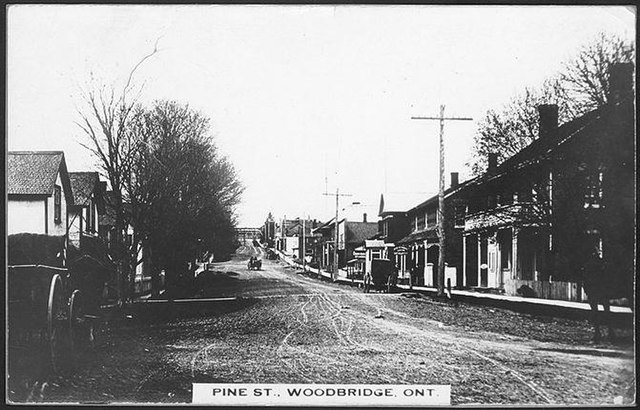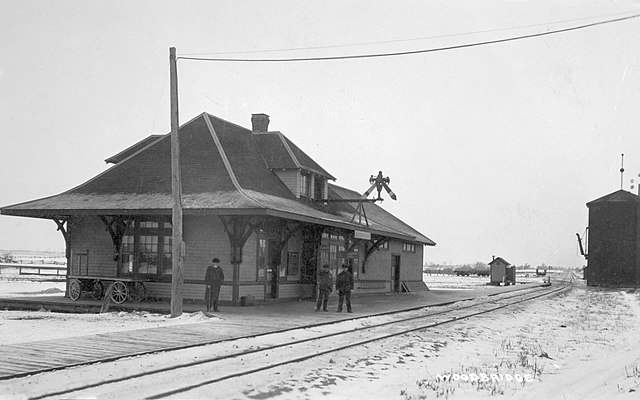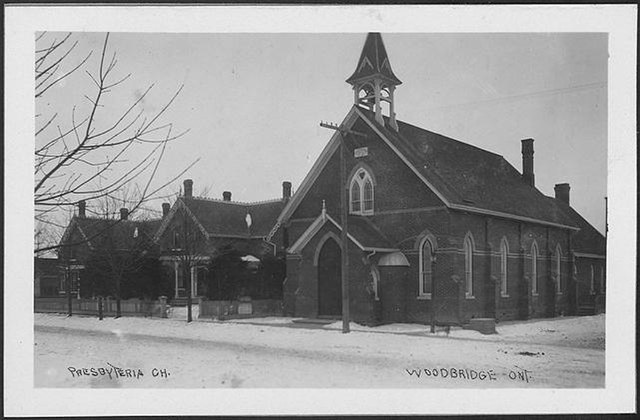IS WOODBRIDGE THE SAME AS VAUGHAN?
Woodbridge is one of four historic villages within the GTA‘s City of Vaughan. The Woodbridge Heritage Conservation District (HCD) Study Area represents one of the city’s highest concentrations of heritage properties.
Woodbridge, which has its connection to the GTA’s historical past, holds its own within many of the villages which grew to eventually become a part of what is now known as the Greater Toronto Area. Woodbridge has always been an attractive place to live and do business since its founding. This is because of its location within the valley, being associated with the Humber River; and its proximity to other communities.
The History of Woodbridge
Who Built Woodbridge?
Woodbridge had its origins with the British Crown granting the west half of Lots 6 and 7 and Concession 7 of Vaughan Township to Jacob Philips and Hugh Cameron in 1802. Settlement had begun in the pre-1900s with the construction of a school house (now demolished), two churches which still remain and the development of the first major transport link in the form of the Toronto Grey and Bruce Railroad having a Station at Woodbridge in the late 1800s. Throughout the 1800s, factories, mills and farmland continued to attract settlers until the late 1800s, their houses include those of the Gothic Revival style.
Woodbridge proper, however, did not begin to take the form of a settlement or village until the arrival of Rowland Burr in 1837 when he obtained land and water mill rights. Burr was very soon recognized as the “founder of Woodbridge”, being the one responsible for undertaking the original layout of the village on a definite plan. His first mill was built at the present location of Woodbridge and Kipling Avenue by the Humber River.
The settlement became known as the Village of “Burwick”. In that same year, the first post office for Vaughan was established in Woodbridge. In 1845, John Abell arrived and set up his first factory, and in 1855, he built his home located on 117 Clarence Street, which still remains today as one of the most significant heritage features of Woodbridge. John Abell, as an industrialist, was a key factor in the continued development of Woodbridge until 1886.
How did Woodbridge get its name?
Woodbridge didn’t always have this name and, as a matter of fact, it wasn’t until 1855 that the settlement originally known as Burwick was renamed to Woodbridge mainly because there was continued confusion between another settlement called “Berwick”. The name Woodbridge was deemed appropriate for the area due to the large number of bridges needed to traverse the many streams and tributaries of the Humber River.
By 1862, John Abell had become quite a successful industrialist and established an agricultural implement plant known as the Woodbridge Agricultural Works, which produced the first steam engine to be used in Vaughan and was the main supplier of farm implements for the area. His business encouraged economic prosperity for Woodbridge, providing jobs and encouraging new businesses to flourish such as taverns which sprung up along Kipling Avenue and Woodbridge Avenue to service the plant.
What were the early factors in furthering the development of Woodbridge?
A major factor in the development of Woodbridge was when the Toronto Grey and Bruce narrow gauge railroad became the first railway to service Woodbridge which was built in 1871 just west of Kipling Avenue with a train station located south of Burton’s Lane. The rail line was extensively used, carrying flour from local mills and agricultural tools from the Abell and Patterson factories. The original line and train station were located where the rail line intersected Woodbridge Avenue, in the vicinity of the present location of the fire hall at Kipling Avenue and Woodbridge Avenue.
The Dominion House (Hotel) was erected in 1874 at the north west corner of the intersection to service the train station. The intersection became the “ideal meeting place” for farmers especially on “implement delivery day” which usually encouraged the attendance of the Burwick Brass Band. Clusters of development continued to occur eastward, mostly along Pine Street and Wallace Street where additional factories and mills were located. Most notably, was John Abell’s Woodbridge Agricultural Works, built in 1874.
The original location of the Humber River flowed along the east wall of the buildings. The railway was eventually widened in 1882 and became part of C.P. Rail in 1884. New Construction and Increased Development In 1875, new additions were made to the original schoolhouse and soon after, construction of the Woodbridge Presbyterian Church began in 1877, which is still located at present day #7971 Kipling Avenue, south of William Street. By 1878, increased development continued along Pine Street, now Woodbridge Avenue and Wallace Street. Development included Hotels, a bowling alley, factories, mills, a post office and the Orange Hall. In 1882, Woodbridge was incorporated as an official village with John Abell as the first Reeve and Joel Reaman as the first Clerk.
In 1883, the Toronto Grey and Bruce Railway was acquired by C.P. Rail. In 1885, after alternating between two locations of the Village of Weston and the Village of Woodbridge for several years, the Fairgrounds was permanently located at 100 Porter Avenue along Kipling Avenue where it exists today. The same year also saw the development of the Norton’s Brick Yard at the location of Church and Clarence Street.
What is something in Woodbridge’s history one can still experience today?
Today one can experience a tradition which began over 170 years ago known as the Woodbridge Fair. The first fair was held in 1847 on the property of the Stegmann Estate in Pine Grove on the corner of Gamble Street and Islington Avenue. It was not until 1848, that the fair took place in Woodbridge, on lands formerly called Burwick, and was located along the Humber River flats east of Wallace Street on land owned by John Abell. The Woodbridge Fair was a place where farmers, residents, and business owners could enjoy the harvest time before winter. Today, it is a central place for the community to come together and celebrate the joy of autumn, community agriculture, and history.
What was Woodbridge like in the 1900s
In the early 1900s, the new Canadian Pacific Railway (CPR) station continued to attract new settlers, although in smaller numbers after the departure of John Abell’s factory operations. Turn of the century development included a number of Victorian and Queen Anne Revival properties. Then, in 1907, the railway was moved further east from the original location crossing Kipling Avenue and Porter Avenue where the topography was more conducive to train travel and a new train station was built at the present location of the Woodbridge Foam property.

1914 witnessed the extension of the Toronto Suburban Railway Company Railway Line to Woodbridge and also in 1914 to 1924, the Toronto Electric Railway Company operated a streetcar service that ran from Woodbridge to Keele and Dundas Street in Toronto. In 1921, the abandoned C.P. Rail buildings and part of the track were leased for
99 years to the Woodbridge Farmer’s Cooperative Company. They located their office and hardware store in the old station and warehouse, which was enlarged to stock a variety of merchandise. Also in the early 1900s, the growing popularity of the Fairgrounds brought about more positive change and development to the area.
In the 1920’s, the annual farmer’s fair was proclaimed as the largest Agricultural fair in Canada. The fair, sponsored by the Woodbridge Agricultural Society, continued to support local businesses, culture and community events and was largely recognized as a stage for elite Toronto Society. The existence and success of the six hotels that were established in Woodbridge, are due in large part to the popularity of the Fair which brought local and district visitors as well as visitors from around the world.

The Fair was considered the most important social event of the year. New road developments in and around Woodbridge in the early 1920s also propelled the town forward. The most notable road development was the newly created Provincial Highway 7, along Pine Street (Woodbridge) and Eighth Avenue (Kipling). In 1926, a new bridge over the Humber River was built on Highway 7. This encouraged a 25 percent increase in population in the 1930’s and Woodbridge became known as a suburb of Toronto. Many of the original building structures were demolished to make room for new roads.
This time period also saw the availability of hydro power as well as the development of some of the large banks such as the Royal Bank and the Bank of Nova Scotia. The year 1946 witnessed an increased development of industry such as the Robinson Cotton Mills Factory (now the Woodbridge Foam Corporation), and the Edwards and Edwards furrier and tannery businesses. The 1940’s also ushered in the introduction of sub-division development, whereby subdivision development plans were inspected, regulated and registered by the municipality as a means of guiding future growth for the community. In the 1950’s, the population of Woodbridge tripled after an influx of predominantly Italian immigrants following the end of WWII. This encouraged a pattern of suburban expansion in housing development to accommodate the new settlers.
Between 1951 and 1956, a total of 10 subdivisions were established. All areas of Woodbridge experienced a rapid increase in development and the population jumped to 3000 by the late 1950’s. The initial growth started from Islington east and later expanded west to Martin Grove Road and north east of Langstaff Road. By the early 1960’s, the population of Woodbridge reached 10,000 and in 1971 the new regional government of York Region was established.
The Township was merged with the Village to form the Town of Vaughan. For a period between the 1960’s to the 1980’s, many of the original building structures within Woodbridge were demolished in the name of progress. The Woodbridge Dairy, originally located along the lane to the Fairgrounds, off of Pine Street was demolished in 1970 as a larger delivery area was needed to better service the facility. The Dominion Hotel, a solid brick hotel built in 1874 with its front veranda facing Eighth Avenue (now Kipling Avenue), was first renovated into apartments and in 1979 demolished to make way for the development of the Nino D’Aversa Italian Bakery.
The Bank of Nova Scotia Building, erected in 1918, was demolished in 1979 and replaced by the Fairground Lane Development Homes. In the same year, the old Woodbridge Farmer’s Train Station was also demolished to make room for the extension of Woodbridge Avenue and the new fire hall. Suburban housing development continued to expand north to Langstaff Road and to central Woodbridge, where many of the older stores were converted to multi units. BY the mid 1980’s, the population had grown to approximately 40,000 people.
In 1991, Vaughan changed its legal status to the City of Vaughan. Housing development continued to expand north and east. Industrial areas were established west, south and east of Woodbridge and by 1996, condominium development began to appear, with the first construction north of Woodbridge Avenue and the Humber River.
Today, Vaughan continues to be one of the fastest growing cities in Canada, with a population of over 320,000 and Woodbridge’s population is currently estimated to be over 100,000 but regardless of its growth, Woodbridge still maintains a significant feel of its historic past and village quality today. So if you wish to witness for yourself that heartwarming village feeling of Woodbridge’s past, you can always partake in its historic fall festival or you can always enjoy its wonderful Italian bakeries and cafes today.
Buying or Selling Real Estate In Woodbridge?
Are you considering moving to Woodbridge or perhaps relocating within the city?
Get expert real estate advice from Frank Leo & Associates to plan your next real estate move. With decades of experience buying & selling real estate in the Greater Toronto Area as well as a million-dollar marketing system to get your property sold GUARANTEED, we’re here to help no matter what your real estate venture may be.
Contact one of our representatives for help finding your dream home, browse current listings in Woodbridge, or get started selling with Frank Leo & Associates by claiming your FREE home evaluation right now.